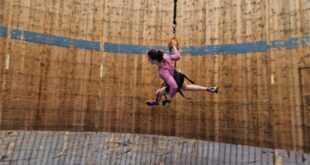Gorgosaurus's last supper represents most complete remains ever found of bird-like species

Scientists have made a rare and extraordinary fossil find in Alberta — a young tyrannosaur with the remains of two baby dinosaurs inside its stomach.
The discovery offers new hints about how tyrannosaurs' behaviour and their role in ecosystems changed as they grew, say the Canadian researchers who led their study, published Friday in Science Advances.
Fewer than two dozen dinosaurs have ever been found with stomach contents, and most of them have been plant eaters, making this a very rare find.
And in fact, the meals themselves — the legs of two juvenile bird-like dinosaurs called Citipes elegans — were also an exceptional find, said Francois Therrien, a Canadian paleontologist who co-led the study.
"They're very rare animals," he said. "What's really interesting is…the stomach contents are the most complete skeletons of citipes ever discovered."
About 75 million years ago, during the Late Cretaceous, the badlands of Alberta were a subtropical coastal plain on the western shore of an inland sea that divided North America. Herds of duck-billed dinosaurs like parasaurolophus, horned dinosaurs like centrosaurus and dome-headed dinosaurs like stegoceras were among the many species that grazed among palm trees and evergreens along winding rivers, where they were hunted by the huge tyrannosaur Gorgosaurus libratus.
Many remains of these giants have been preserved and excavated, but the more fragile bones of smaller and younger dinosaurs are much rarer.
So there was a lot of excitement when Darren Tanke, a technician from the Royal Tyrrell Museum in Drumheller, Alta., spotted the bones of a young tyrannosaur sticking out of the ground in Dinosaur Provincial Park in 2009. At the time of its death, it was just four metres long — less than half the length of a school-bus sized adult — and just a third of a tonne or a tenth of its adult weight. The researchers later estimated it was between five and seven years old — still years away from transitioning to an adult, which started at around eleven years old.

Dinosaurs inside a dinosaur
After excavation, Tanke brought it back to the museum and was carefully removing the rock when he noticed some small toe bones sticking out of the rib cage, recalled Therrien, the museum's curator of dinosaur paleoecology.
The team decided to flip the fossil over and prepare it from the other side to see what the toe bones were attached to.
As it turns out, they belonged to two complete pairs of legs and feet. The feet were identical to fossil feet that were previously found, belonging to a bird-like dinosaur known as Citipes elegans. Therrien said it resembled a modern-day bird called a cassowary, and was a little bit smaller than an emu when fully grown. But the small legs found in the tyrannosaur's stomach were those of babies, estimated to be about a year old and the size of a turkey.
One pair of legs was more digested than the other, suggesting it had been eaten hours or days earlier. No other parts of the animal were found.
"So we could tell that our tyrannosaur was fond of drumsticks," Therrien joked. He suggested that the animal may have eaten only that part because it was the meatiest.

The researchers were quite interested to learn more about what young tyrannosaurs were eating, as they suspected it was different from what they ate as adults. Gorgosaurus grew to be nine metres long and weighed two to three tonnes, with huge, crushing teeth that Therrien calls "killer bananas" because of their shape.
Scientists think they hunted herds of huge, lumbering plant-eating dinosaurs, based on tyrannosaur tooth marks on the bones of their prey and sometimes tyrannosaur teeth embedded in the bones, said Darla Zelenitsky, a University of Calgary paleontologist who co-led the new study.
Zelenitsky's graduate student Jared Voris, also a co-author of the new study, has studied the growth of gorgosaurus in detail, describing the huge changes in its build.
"What we see with these juvenile tyrannosaurs is they're very lightly built and very gracile compared to the adults, which are very massive and robust," Zelenitsky said.
Young tyrannosaurs also have very different teeth – not banana shaped, but blade-like for slicing rather than crushing.
Because of that, researchers had long suspected they ate different foods from adults, much as today's crocodiles and Komodo dragons switch to bigger prey as they grow. The latest discovery supports that hypothesis. "These teenage tyrannosaurs were obviously eating … small, young and swift prey," Zelenitsky said.
Therrien said that helps explain why all the small- and medium-sized predators disappeared after large tyrannosaurs evolved; their prey was being eaten by younger tyrannosaurs. "That gives us a lot of better appreciation I think for why tyrannosaurs are so unique."

Hans Larsson is Canada Research Chair in vertebrate paleontology at McGill University in Montreal. He published a study a year ago on a small dinosaur called a microraptor found with mammal remains in its stomach. Larsson said the preservation of gut contents in carnivorous dinosaur fossils is "exceedingly rare" and he had counted only 21 such cases at the time of his study.
In this case, he said, "What is cool is the size of the prey is pretty big."
Solo or pack hunter?
Therrien and his colleagues think the citipes legs wouldn't have made much of a meal for more than one young gorgosaurus, and therefore it likely hunted alone. But Larsson thinks the young citipes was fairly large if you consider the entire animal and not just its legs.
That's consistent with a pattern in mammals, he said, where once they grow bigger than a medium-sized dog, they hunt much larger prey by hunting in packs. Larsson noted that most predators eat the entire animal unless they have to share, and he doubted that the gorgosaurus would have eaten only the legs had it been hunting alone.
Joseph Peterson, a paleontologist at the University of Wisconsin, Oshkosh, said there are many possible reasons why the young gorgosaurus only ate the legs of its prey. He thinks the Alberta researchers' explanation that it was because they were the meatiest part is plausible. He also noted that most predators will scavenge the prey of other predators if they find it.
Peterson had previously found bite marks from a young Tyrannosaurus rex, a few years older than the gorgosaurus in the new study, on the bones of duck-billed dinosaur, a large hadrosaur. That study suggested that tyrannosaurs switched to large prey even before their juvenile slicing teeth transitioned to adult crushing teeth.
The discovery that smaller juveniles stuck with smaller prey makes sense, Peterson said.
He added that while individual studies don't offer much more than neat stories, "when you get enough of them together like this … you can start putting together a much more comprehensive picture of what the world was like back then, how these animals were interacting," he said. "It's pretty exciting."
*****
Credit belongs to : www.cbc.ca
 MaharlikaNews | Canada Leading Online Filipino Newspaper Portal The No. 1 most engaged information website for Filipino – Canadian in Canada. MaharlikaNews.com received almost a quarter a million visitors in 2020.
MaharlikaNews | Canada Leading Online Filipino Newspaper Portal The No. 1 most engaged information website for Filipino – Canadian in Canada. MaharlikaNews.com received almost a quarter a million visitors in 2020.







